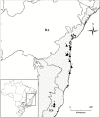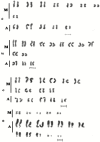Genetic Characterization of Some Neoponera (Hymenoptera: Formicidae) Populations Within the foetida Species Complex
- PMID: 30137374
- PMCID: PMC6105101
- DOI: 10.1093/jisesa/iey079
Genetic Characterization of Some Neoponera (Hymenoptera: Formicidae) Populations Within the foetida Species Complex
Abstract
The foetida species complex comprises 13 Neotropical species in the ant genus Neoponera. Neoponera villosa Fabricius (1804) , Neoponera inversa Smith (1858), Neoponera bactronica Fernandes, Oliveira & Delabie (2013), and Neoponera curvinodis (Forel, 1899) have had an ambiguous taxonomic status for more than two decades. In southern Bahia, Brazil, these four species are frequently found in sympatry. Here we used Bayesian Inference and maximum likelihood analyses of COI and 16S mtDNA sequence data and conventional cytogenetic data together with observations on morphology to characterize sympatric populations of N. villosa, N. inversa, N. bactronica, and N. curvinodis. Our results showed marked differences in the karyotype of these ants. Both N. curvinodis and N. inversa have chromosome number of 2n = 30. Their chromosome composition, however, is distinct, which indicates that N. curvinodis is more closely related to N. bactronica. These four species clustered into three distinct groups. The close relationship between N. bactronica and N. curvinodis deserves further investigation since it has not been fully resolved here. Our results confirm that N. inversa, N. villosa, N. bactronica + N. curvinodis indeed represent four distinct taxa within the foetida species complex.
Figures




References
-
- Bacci M. Jr, Solomon S. E., Mueller U. G., Martins V. G., Carvalho A. O., Vieira L. G., and Silva-Pinhati A. C.. 2009. Phylogeny of leafcutter ants in the genus Atta Fabricius (Formicidae: Attini) based on mitochondrial and nuclear DNA sequences. Mol. Phylogenet. Evol. 51: 427–437. - PubMed
-
- Bächtold A., Kaminski L. A., Magaldi L. M., Oliveira P. S., Del-Claro K., Janzen D. H., Burns J. M., Grishin N., Hajibabaei M., Hallwachs W.,. et al. 2017. Integrative data helps the assessment of a butterfly within the Udranomia kikkawai species complex (Lepidoptera: Hesperiidae): immature stages, natural history, and molecular evidence. Zool. Anz. 266: 169–176.
-
- Barcellos M. S., Martins L. C., Cossolin J. F., Serrão J. E., Delabie J. H., and Lino-Neto J.. 2015. Testes and spermatozoa as characters for distinguishing two ant species of the genus Neoponera (Hymenoptera: Formicidae). Fla. Entomol. 98: 1254–1256.
-
- Barr N. B., Cui L., and McPheron B. A.. 2005. Molecular systematics and sequence analysis of the nuclear gene period in the genus Anastrepha (Tephritidae). Ann. Entomol. Soc. Am. 98: 173–180.
-
- Barr N. B., Ruiz-Arce R., Farris R. E., Silva J. G., Lima K. M., Dutra V. S., Ronchi-Teles B., Kerr P. H., Norrbom A. L., Nolazco N.,. et al. 2018. Identifying Anastrepha (Diptera; Tephritidae) Species Using DNA Barcodes. J. Econ. Entomol. 111: 405–421. - PubMed
MeSH terms
Substances
LinkOut - more resources
Full Text Sources
Other Literature Sources

